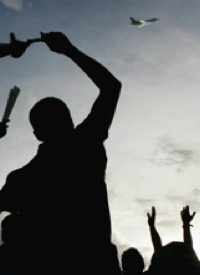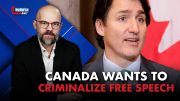
The plane circled the airport at a very low altitude twice before giving up and flying to an airport in neighboring Nicaragua. As his plane circled above, hundreds of his supporters tried to gain access to the airport and were repelled by riot police and soldiers who fired tear gas to disperse the crowds. At least one protester was killed and eight more were injured during the disorder.
Zelaya gave interviews from the air to Telesur, a leftist Venezuelan network, as his plane approached Tegucigalpa. The ousted president said: "No one can obligate me to turn around. The Constitution prohibits expelling Hondurans from the country. I am returning with all of my constitutional guarantees."
As his plane neared the airport, Zelaya, speaking on television, asked members of Honduras’s military to support him "in the name of God, in the name of the people, and in the name of justice."
The New York Times reported that the entry of the plane into Honduran airspace and its low-altitude flight around the Honduran capital angered some members of Honduras’ air force. An air force officer who spoke on the condition of anonymity said: "That was a flagrant violation of our sovereignty by a Venezuelan aircraft. They entered our airspace without permission and they were flying lower than allowed. It was an act of provocation."
As the attempted return by Zelaya to Honduras produced some tense moments, the new government headed by President Roberto Micheletti told the Organization of American States it wants to start talks related to the dispute for control of the nation’s presidency. However, the Times quoted Micheletti ‘s statement of concern that the return of Zelaya to Honduras would stimulate violence. "We don’t want internal conflicts," said Micheletti. "We don’t want bloodshed and this could be the consequence of his coming back."
Similar sentiments were expressed by Cardinal Oscar Rodriguez, the Archbishop of Tegucigalpa, who read a message from the nation’s Catholic Bishops’ Conference on national radio and television, on July 5: "We think that [Zelaya’s] return to the country at the moment could provoke a bloodbath. To this day no Honduran has died. Please think, because afterwards it will be too late."
The OAS expelled Honduras on July 5 at an extraordinary session of its general assembly held in Washington. The expulsion was based on Article 21 of the OAS Charter that gives member nations the right to suspend membership of a country in case of an "unconstitutional interruption of democratic order" and when "efforts to address the situation through diplomatic means have failed."
The measure had been recommended by OAS Secretary General Jose Miguel Insulza, who said that "no other alternative existed" but to exclude Honduras, which refused to reinstate Zelaya. Insulza a Chilean socialist, was once a political adviser to the Chilean Ministry of Foreign Affairs under the Marxist Salvador Allende.
During his unsuccesfull attempt to land in the Honduran capital, Zelaya was accompanied by UN General Assembly President Miguel d’Escoto Brockmann, a leftist Maryknoll priest, who — as a proponent of "liberation theology" — once joined the communist Sandinista guerrillas that overthrew the nation’s conservative President Anastasio Somoza in 1979. (D’Escoto was suspended by the Vatican in the 1980s and publicly reprimanded by Pope John Paul II for his radical activities.)
In April 1984, when he was foreign minister for a Nicaraguan government ruled by the Junta of National Reconstruction that included Sandinista leader Daniel Ortega, D’Escoto filed an affidavit before the World Court declaring that "my government is not engaged, and has not been engaged in, the provision of arms or other supplies to either of the factions engaged in the civil war in El Salvador."
However, a 1983 U.S. State Department report stated that at least since 1980 the Sandinista government of Nicaragua had "engaged in a carefully concerted use of force against its neighbors." House Intelligence Committee Chairman Edward Boland (D-Mass.) stated in March 1982: "There is … persuasive evidence that the Sandinista government of Nicaragua is helping train insurgents and is transferring arms and financial support from and through Nicaragua to the insurgents. They are further providing the insurgents bases of operations in Nicaragua."
Referring to specific countries, the report offered considerable documentation of Sandinista efforts to destabilize El Salvador, Honduras, and Costa Rica. It charged the Nicaraguan communists with "providing the arms, training areas, command and control facilities, and communications that transformed disorganized factions in El Salvador into a well-organized and equipped guerrilla force of several thousand responsible for many thousands of civilian casualties and direct economic damages of over $1 billion."
The most prominent Sandinista leader during the years 1985-1990 was Daniel Ortega. Following an electoral defeat in 1990, Ortega remained out of office until the election of 2006, when he was returned to power. Among those who congratulated Ortega on his victory were President Hugo Chavez of Venezuela and President Fidel Castro of Cuba. Chavez, speaking by telephone to Ortega, chanted "long live the Sandinista revolution!"
This is, of course, the same Chavez who has shown so much support for Zelaya during the present power struggle. With Chavez’ friend Ortega (who claims to have reformed his ways by abandoning Marxism and embracing Catholicism) now in charge of Nicaragua, it is easy to understand why Micheletti is casting a nervous eye towards the Nicaraguan border. The New York Times reported:
Tensions were high throughout the region. Mr. Micheletti said that Nicaraguan troops had been observed near the Honduras border, which he called a provocation. He called on President Daniel Ortega of Nicaragua to withdraw the troops and vowed to defend Honduran territory.
But Mr. Ortega denied in a radio interview that any troops were massing, and American officials in Washington said they lacked any information of Nicaraguan troop movements.
Central America is a region that historically is known for the instability of its politics. The surest way to understand most crises in the region, however, is to keep one’s eye on the Marxists — "former" or otherwise.
Photo: AP Images



